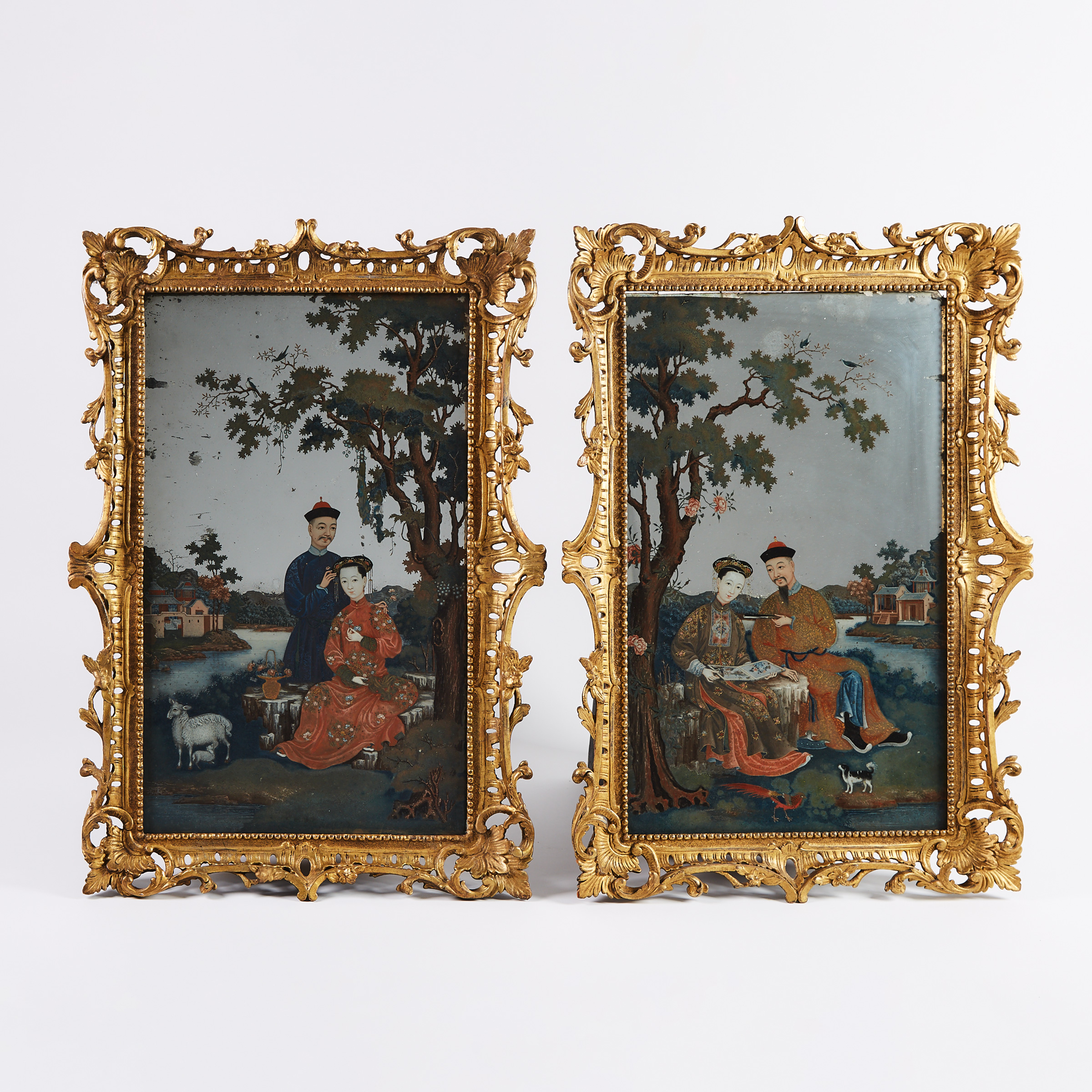Lot 281
A Pair of Chinese Export Reverse Painted Mirrors, 18th Century

Lot 281 Details
A Pair of Chinese Export Reverse Painted Mirrors, 18th Century
十八世紀 外銷人物風景玻璃畫一套兩件
Each of a river landscape, the foreground of one with a man and lady holding picked flowers with a sheep and lamb, the other with another couple admiring a painting album with a dog and a golden pheasant, in their original pierce carved giltwood Chippendale frames
overall 32" x 22.5" — 81.3 x 57.2 cm.
Estimate $20,000-$30,000
Provenance:
Purchased from H. Blairman & Sons, London in 1968, thence by descent; original invoice available upon request.
由藏家1968年購於英國倫敦H. Blairman & Sons,原始購買憑證可私
Note:
The technique of painting on glass was introduced to China with the arrival of Giuseppe Castiglione (1688-1715), the Jesuit missionary. The popularity of European aesthetic and artistic techniques in the Chinese Imperial court was mirrored by the emergence of ‘Chinoiserie’ tastes in West. Glass and mirror paintings became a product of the two trends, where plates were painted with idyllic and exoticized scenes of the Far East using European painting techniques. The operation was arduous; mirror plates were sent from Europe over to Chinese workshops, where they would strip sections of mercury and carefully paint designs on the reverse. Once complete, the plates would be laboriously transported back to the West, further adding to their rarity and value.
For similar examples and further discussion, please see Sotheby’s London: Magnificent Chinese Mirror Paintings and English Furniture from the Horlick Collection, June 5, 2007.
A similar example sold at Bonhams London, November 8, 2018, Lot 279.
清代初期,玻璃畫由西方傳入中國,經過我國的民間藝人的藝術加工、創造成為一門獨特的藝術風格。乾隆時期鏡畫藝術得到最大的發展。但數量較少。清晚期,玻璃的制造工藝有了很大的發展,生產量大增。鏡畫的傳統手法,通常在絲網上繪上圖,再印到玻璃上,用畫筆蘸顏料塗上顏色,再裝上鏡框,制作過程並不復雜。玻璃畫的畫面圖案的內容大多是顏色鮮艷的景物、美女、人物仕女、歷史故事、花鳥魚蟲,再加上祝福的話,在當時婚嫁送禮都少不了它。
隨著18世紀清代外貿繼續增長,出口商品除絲綢、陶瓷、漆木家具等外,還有繪畫作品。有充分的記載和實物證明18世紀廣州出口畫作坊就已經相當活躍。而外銷畫出現的主要原因是因為外僑習慣在居室中懸掛家族成員和先人的肖像畫,通常還需要一些風景畫、靜物畫或中國風書畫作為補壁之用,這些為外僑定制或直接出售給他們的繪畫就是外銷畫。這些畫後來由外僑輾轉輸送到海外。由廣東出口的玻璃畫(或鏡子畫)則屬於此類外銷畫的一種。即畫在玻璃上,一般鑲有歐洲風格的雕花金色鏡框。這些玻璃畫用中國毛筆,以膠彩或油彩畫在玻璃的背面,由於畫工精細,深受歐洲人的喜愛與珍惜。 玻璃畫具有很高的藝術欣賞和收藏價值,乾隆時期平板玻璃的舶來或自產品的價格都相當昂貴,據乾隆年間價格折算,一平方米進口的平板玻璃,紋銀達十五兩,加上畫工就更貴了。因此早期的玻璃畫是非常稀少而又珍貴的,今日已經很難找到。
類似成交紀錄可見倫敦邦瀚斯,十一月八日拍賣,第279號拍品。


